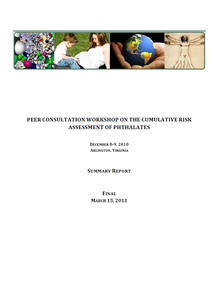EPA Peer Consultation Workshop on Cumulative Risk Assessment of Phthalates: Potential Options and Methods for Evaluating the Cumulative Hazard Associated with Six Selected Phthalates
On this page:
Notice
Overview
The specific objectives of this workshop were to:
- Evaluate cumulative hazard and dose response assessment recommendations presented in the 2008 National Academies of Science (NAS) report "Phthalates and Cumulative Risk Assessment-The Tasks Ahead"
- Discuss approaches for determining cumulative risk associated with exposure to multiple phthalates
- Generate workshop proceedings to assist the EPA phthalate workgroup in decision making regarding options and preferred methods for development of the cumulative risk assessment for phthalates
Citation
U.S. EPA. EPA Peer Consultation Workshop on Cumulative Risk Assessment of Phthalates: Potential Options and Methods for Evaluating the Cumulative Hazard Associated with Six Selected Phthalates. U.S. Environmental Protection Agency, Washington, D.C., 2011.
Background

Phthalate esters are a group of chemicals used in the manufacture of polyvinyl plastics and other materials such as pharmaceuticals, detergents, toys, cosmetic and personal care products, medical devices and food packaging to increase flexibility and pliability. Humans are exposed to various phthalates in the environment through direct contact with these products resulting in phthalates or their metabolites being detected in human saliva, urine, amniotic fluid, and breast milk. Epidemiological studies have demonstrated a possible association between exposure to multiple phthalates and indicators of potential effects on the male reproductive system at exposure levels similar to background levels observed in the population.
Because humans are potentially exposed to multiple phthalates in the environment, EPA is evaluating the cumulative risk associated with these chemicals in an assessment of human health hazard of phthalates. Specifically, EPA asked external experts from the National Academies of Science (NAS) to evaluate the issues and approaches related to the cumulative hazard assessment of phthalates.
On December 18, 2008, the NAS released the report, “Phthalates and Cumulative Risk Assessment—The Tasks Ahead.” The NAS recommended that EPA select phthalates for inclusion in a cumulative risk assessment based on common adverse outcomes rather than focusing exclusively on structural similarity or on similar mechanisms of action. The NAS concluded that a sole focus on phthalates which excluded other anti-androgens would be artificial and could seriously underestimate cumulative risk.
EPA is following the NAS’ recommendation and is currently developing an Integrated Risk Information System (IRIS) human health assessment for six phthalates and a cumulative hazard assessment based on common adverse outcomes. The IRIS assessment includes the following phthalates: dibutyl phthalate (DBP), di(2-ethylhexyl)phthalate (DEHP), butyl benzyl phthalate (BBP), di-isobutyl phthalate (DIBP), di-isononyl phthalate (DINP), and dipentyl phthalate (DPP). The IRIS Human Health Assessment for Selected Phthalates will include qualitative and quantitative analyses of noncancer and cancer effects information. The IRIS Human Health Assessment for Selected Phthalates will result in a cumulative hazard assessment as well as separate IRIS summaries for each of the six phthalates. It is expected that this cumulative assessment will serve as a future framework for the evaluation of other compounds that cause similar adverse outcome(s). Public comment and external peer review of the draft IRIS Human Health Assessment for Selected Phthalates document is anticipated to occur in Spring 2013.
History/Chronology
| Date | Description |
|---|---|
| Nov 2010 | EPA announced a public peer review workshop to review the recommendations for evaluation of the cumulative mixtures risk of phthalates as set forth in the National Academies of Science (NAS) report and propose additional methods and approaches that may facilitate the assessment of risk(s) associated with exposure to cumulative mixtures of the six selected phthalates. [Federal Register Notice Nov 15, 2010] |
| Dec 2010 | EPA held an independent peer consultation workshop on the cumulative risk assessment of phthalates. |
Status
The phthalate assessment(s) are undergoing development, see IRIS Track for specific details. The finished assessment will be released on the IRIS Web site.
Download(s)
This document has been reviewed in accordance with U.S. Environmental Protection Agency policy and approved for publication. Mention of trade names or commercial products does not constitute endorsement or recommendation for use.
- EPA Peer Consultation Workshop on Cumulative Risk Assessment of Phthalates: Potential Options and Methods for Evaluating the Cumulative Hazard Associated with Six Selected Phthalates (Final Report) (PDF) (61 pp, 1 MB, about PDF)
- Agenda for EPA Peer Consultation Workshop on Cumulative Risk Assessment of Phthalates (PDF) (2 pp, 31 KB, about PDF)
- Meeting Facilitator, Panelists, and Discussants for EPA Peer Consultation Workshop on Cumulative Risk Assessment of Phthalates (PDF) (1 pp, 24 KB, about PDF)
- Workshop Information and Background (PDF) (3 pp, 32 KB, about PDF)
If you have a disability and the format of any material on our web pages interferes with your ability to access the information, please reach out to us using the Contact us about IRIS form for assistance. To enable us to respond in a manner most helpful to you, please indicate the nature of the accessibility problem, the web address of the requested material, your preferred format in which you want to receive the material (electronic format (ASCII, etc.), standard print, large print, etc.), and your contact information.
